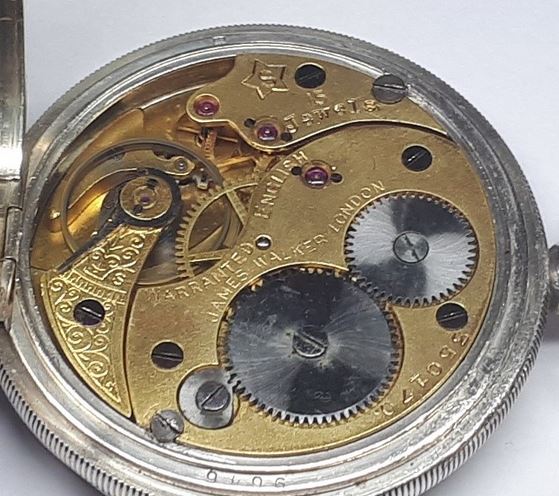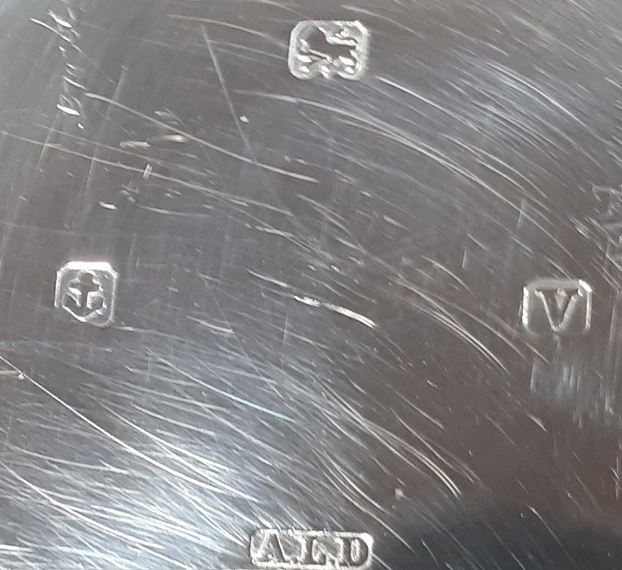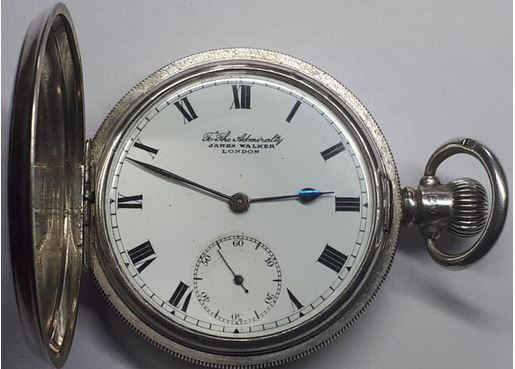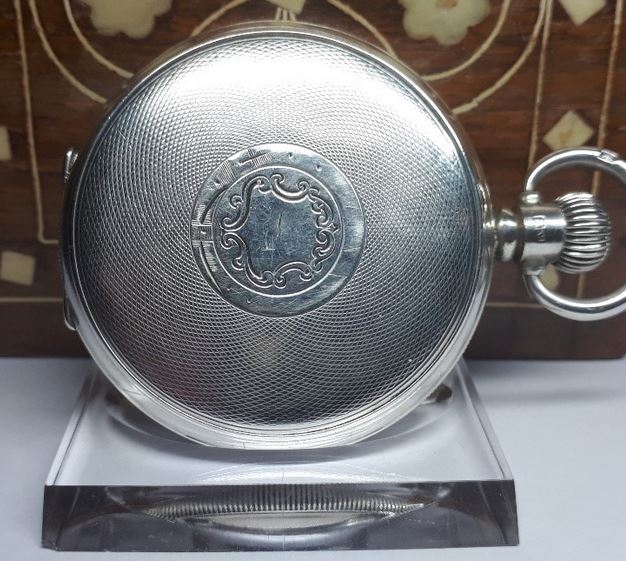Last updated on May 14, 2024
It has been a while since I have added to my collection. The more I learn about antique watches, the more selective I become when searching for timepieces to buy. I have learnt about the things you should avoid when buying an antique watch. However, I also enjoy researching the timepieces that I am looking to buy. Generally, I like to add something different to my collection with each addition. In this case, I have purchased a full hunter pocket watch that was retailed by James Walker Ltd. The watch is sitting on the desk in front of me and ticking loudly as I type.
Movement
The watch has a good quality 15-jewel English stem-winding movement which is working nicely. The movement is signed with the letter S within a five-pointed star. This was the mark for the Coventry watchmaker H Williamson. In 1921, just a year after this particular watch was manufactured, the company merged with Grimshaw, Baxter and J.J. Elliott to become The English Watch & Clock Manufacturers Ltd. This company was forced into receivership and was subsequently bought by the Cheltenham based company Smiths English Clocks in 1932. The movement is protected by an inner hinged cover which has some light surface scratching. The movement is stamped “WARRANTED ENGLISH”. In accordance with the 1887 British Merchandise Marks Act, this was to prove that the movement was made in Britain and not a foreign import falsely claiming to be British-made.
Case
The watch measures 50mm in diameter excluding the winding stem and the loop. The case is hallmarked for Birmingham 1920 with a maker’s mark for the Birmingham watch case maker Aaron Dennison. The case has an engine-turned detail to both the front and back. There is also a cartouche to the front which has a couple of marks. I consider this to be patina, which I think adds character. This was clearly a watch that was worn and used.
The Dennison Watch Case Company
Aaron Dennison (1812 – 1895) was an American-born businessman. He trained as a watchmaker and had a long career in the watchmaking industry. He worked for several watchmaking companies, including one that was to eventually become the Waltham Watch Company. In 1864, Dennison founded the Tremont Watch Company in Boston. He intended to use imported components from Swiss manufacturers because labour costs were lower. Dennison left a business partner in charge in Boston and moved to Switzerland to oversee operations. The Tremont Watch Company fell into financial difficulties in 1870. As a result, Dennison moved to England. In 1874, he founded the very successful Dennison Watch Case Company in Birmingham.
The business began in a small workshop beside the family home. Originally, the company was called Dennison, Wigley & Company and it grew to produce 100,000 high-quality watch cases per year. When Dennison died in 1895, he was succeeded in business by his son, Franklin Dennison. The company was renamed the Dennison Watch Case Company Ltd in 1905 and continued as a successful business until 1967.
Hunter case
The winding crown pushes in to open the hunter case. The cover springs open cleanly to just under 90 degrees, which is to be expected. Inside, there is an acrylic lens that has light surface marking. This is obviously a replacement for the original crystal lens. Acrylic wasn’t invented until the late 1920s.
The enamel dial is in near mint condition, looking pristine to the naked eye. Under magnification there are some very minor blemishes, but with no signs of any hairline cracks. The hands are original and are made from blued steel. Bluing steel is a process that creates an oxidised coating that prevents corrosion. First, the hands are cleaned and polished. Next, the hands are heated, over a bed of brass filings, to a high temperature. The layer of brass filings is used to maintain a stable temperature. The steel changes colour from gold to brown and then purple before it settles to blue. The dial also has a subsidiary seconds dial and an outer minute track.
The dial is also signed “To the Admiralty, James Walker, London”. The watch was made as a private label piece so that James Walker Ltd, the original retailer, could sell it under their name. The Admiralty claim is likely a marketing ploy. Claiming association with Royalty was difficult without a Royal Warrant and could lead to charges in court. The Admiralty, is likely the next best thing, with less chance of legal action. Marine navigation requires accurate clocks, so claiming association with the Admiralty, implies an accurate timepiece. It has been suggested that watchmakers may have sent free examples of their work to the Admiralty to justify their claim.
James Walker Ltd
James Walker Ltd was a major high street jewellery chain. The company was founded in 1902 by Sidney Sanders (1871-1942) and William Metherell (1877-1936). Their first shop was located on Streatham High Road, Streatham. In 1907 they began trading as Sanders & Co. It must have been a successful partnership, because by 1908, Sanders & Co had its headquarters in Brixton and branches at Peckham, Streatham, and Oxford Street. They sold watches, clocks, and electro-plated goods. Around 1911 they acquired the name James Walker from a jewellers shop in Peckham that had been established since 1823. This was undoubtedly a marketing exercise whereby they purchased some ‘heritage’ for the business. Soon after they formed James Walker Ltd and continued to trade under that name.
Following the First World War the company split into Sanders & Co. and James Walker Ltd. Sanders & Co. continued to trade under William Metherell, but Sidney Sanders left the company so that he could develop James Walker Ltd as a retail chain. During the interwar period, James Walker (Jeweller) Ltd opened over seventy branches in London and the surrounding regions. After the Second World War, James Walker Ltd was reputed to be the second-largest retailer of jewellery and silverware in Britain (after H. Samuel Ltd). In 1969, James Walker Ltd and Sanders & Co merged again under the Walker name. The number of branches grew to 110 outlets around the UK. Ultimately, James Walker Ltd was acquired in 1984, by competitor H. Samuel.
James Walker pocket watch
I am really pleased with the latest addition to my collection. It is a very presentable timepiece with a lovely patina from sustained use. It is also practical as it is an accurate antique watch. The watch passed the 24-hour accuracy test running at approximately 1 minute fast. This is more than acceptable for a watch of this age. The power reserve was 30 hours on a full wind, which is excellent for an antique pocket watch. In my research, I learnt a lot about a once-prominent retailer, James Walker Ltd. I am looking forward to an occasion where I can wear my antique James Walker pocket watch.



